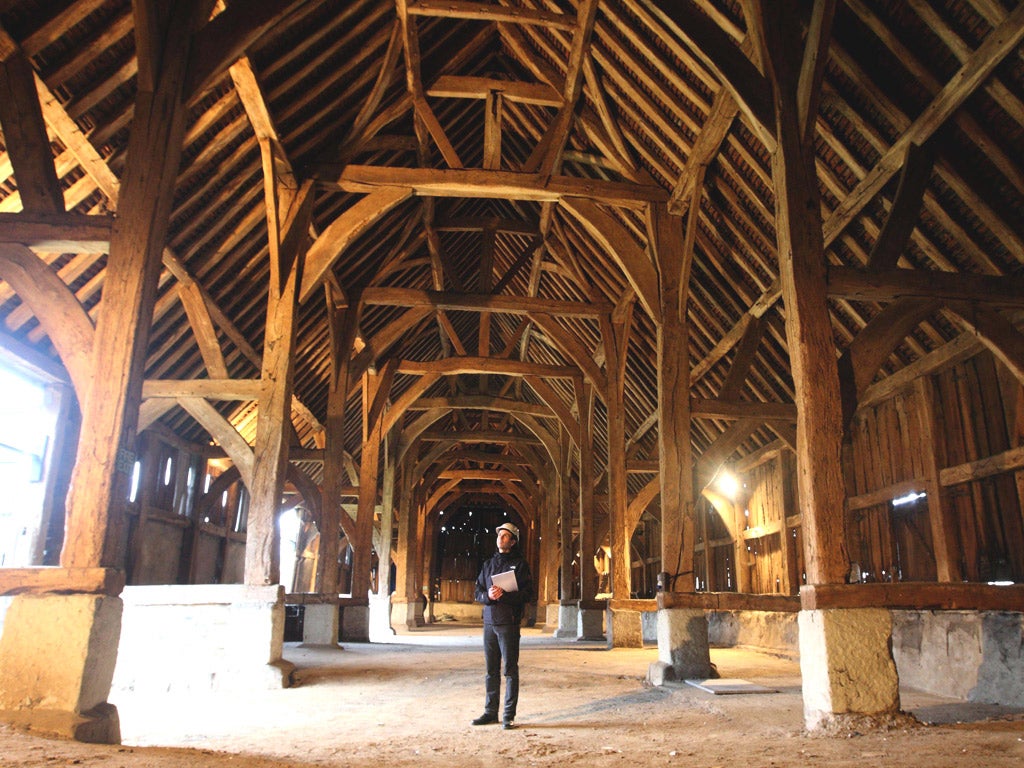
Britain's greatest surviving ancient wooden building, a huge medieval barn dubbed "the Cathedral of Middlesex" by John Betjeman, has been rescued for the nation after years of neglect at the hands of an off-shore property developer who bought it for £1.
Harmondsworth Great Barn, on the northern fringe of Heathrow Airport and within earshot of the M4 motorway, is a miraculous survival from the era of Agincourt. It is one of the nation's most important architectural treasures, hailed as a "masterpiece of carpentry" by English Heritage.
Dating from 1426, early in the reign of boy-king Henry VI and not long after the death of Chaucer, the Great Barn was one of several built in an area now largely swallowed up by the outer west London suburbs.
For centuries this was one of England's wealthiest agricultural regions, a source of wealth and power, but wheat, barley and fruit growing have long since given way to a sprawl of housing, industrial estates, roundabouts and major roads.
In 2006, with upkeep costs rising and the destructive expansion of Heathrow Airport seemingly imminent, the Grade I listed barn was offered for sale for £1 by receivers winding up the then owners of the barn, a local firm. It was snapped up by a property developer through a company, Harmondsworth Barn Ltd, registered in Gibraltar.
A third runway at Heathrow, approved by the last Labour government, would have greatly boosted the value of the land on which the barn stands. But when airport expansion plans were scrapped by the Coalition government in 2010, the barn and its land became a financial liability for its owner.
The Great Barn was built by Winchester College, which held land at Harmondsworth, during the late medieval "infrastructure boom" as Europe recovered from the Black Death of the previous century.
The development of Heathrow Airport, which began in the 1940s, sounded the death-knell for agriculture in Middlesex, and all but one of the region's ancient barns, that at Harmondsworth, were demolished.
Built with the same skill and attention to detail as the great churches and palaces, the Great Barn was a favourite of the architectural historian and poet John Betjeman, who gave it its informal title, the Cathedral of Middlesex, in the 1960s.
The barn is exceptionally rich in original oak timbers – some 98 per cent of which remain in place. It is more than 60 metres long, 12 metres wide and 11 metres tall, with 13 massive oak trusses supporting the vast, tiled roof. A complex lattice of mighty curved braces and beams above a "nave" and a dozen chapel-like bays give the impression of a large medieval church.
By 2006, time was catching up with the Great Barn. Rainwater had started to seep into the building, roof tiles were falling off, weeds sprouted amid its 700-year old timbers, and no fire alarm system or fire-fighting equipment had been installed.
Historic agricultural buildings, especially old barns, are especially vulnerable to damage, accidental or otherwise. In 2004 and 2005, a series of fires at another huge barn, that at Frindsbury, near Rochester, Kent, destroyed four of its 13 bays. Frindsbury Barn dates from 1403.
Despite pressure from English Heritage and local campaigners, the owner of Harmondsworth's Great Barn failed to carry out any repairs. In 2009, in the wake of coverage in Cornerstone magazine, published by the Society for the Protection of Ancient Buildings (SPAB), English Heritage served an Urgent Works Notice on the owner, requiring repairs to be carried out. The barn's owner still refused to co-operate, so English Heritage carried out repairs itself. While seeking to recover the full cost of these repairs from the owner, English Heritage struck a deal with Harmondsworth Barn Ltd to buy the building for £20,000.
"We've long respected our cathedrals and great houses from the Middle Ages, but the best of the great barns, like Harmondsworth, are equally worthy of respect and protection," says Matthew Slocombe, incoming Director of the SPAB, founded by William Morris and which counts Betjeman among its former officers. "These great barns are symbols of the dominance of the rural economy in the past, and the immense investment in craftsmanship and materials that agriculture deserved.
"The imposing tithe barn at Bradford on Avon in Wiltshire, with its lavish, stone-covered roof, is already in English Heritage's guardianship, and the exceptionally early Cressing Temple barns in Essex, dating from the 13 century, are now cared for by Essex County Council after narrowly escaping loss. We're delighted to hear of English Heritage's positive action at Harmondsworth."
Last week, English Heritage, which sees the purchase of the Great Barn as a welcome victory after a long series of drastic cuts in its budget, told the Independent that the building is " a supreme example of late-medieval craftsmanship - a masterpiece of carpentry containing one of the best and most intact interiors of its age and type in all of Europe".
English Heritage will be handing over the running of Harmondsworth's Great Barn to members of local campaign group The Friends of the Great Barn at Harmondsworth. It is expected to be open to the public from this April. Full details will be posted on the English Heritage website.
Join our commenting forum
Join thought-provoking conversations, follow other Independent readers and see their replies
Comments